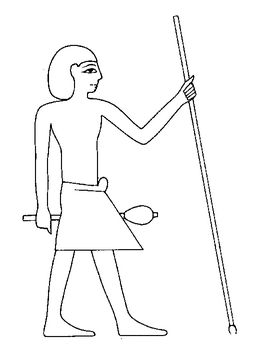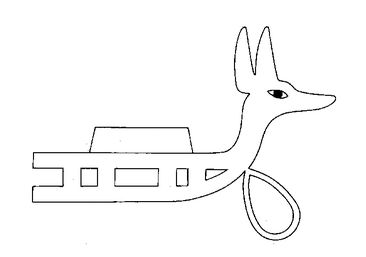Think Like an Egyptian (38 page)
Read Think Like an Egyptian Online
Authors: Barry Kemp

The sources tend to emphasize celebration and indulgence in extra food and drink during festivals. Yet the hieroglyph, in combining the images of a tent-shrine of matting supported by a papyrus column and an alabaster bowl for pure water, sought a more austere association with very traditional buildings and the idea of purity.
Some festivals belonged to only one locality. Particularly famous was the Festival of Opet, which underpinned the primacy of the city of Thebes in state religion and, for several centuries, the power of the royal family, which was of Theban origin. It began during the second month of the Inundation season and lasted for between 24 and 27 days. For this festival the ornate portable barques of Amun, Mut, and Khensu—the holy family of Thebes—were conveyed to the temple of Luxor, nearly three kilometers to the south. The king joined them inside the temple and in a set of rituals the power of his ka was enhanced through contact with the kas of his predecessors (see no. 73, “Ka”). In another festival at Thebes, the Beautiful Festival of the Valley, the same portable barques were taken across the Nile to the huge cemetery of Thebes and to several of the mortuary temples of the kings. It was an occasion for private families with relatives or ancestors buried in the Theban hills to make their own journey to the family tomb, to have a meal there, and to stay overnight. For the workmen of Deir el-Medina, their principal festival was that of their founder, King Amenhetep I, “the lord of the village.” One text tells how “the gang rejoiced before him for four solid days of drinking together with their children and their wives.” Extra rations were given out by the state, and men and women sang and drummed.
Egyptian kings celebrated a long reign with a jubilee festival called the Sed festival. Images of provincial gods were taken to a ceremonial site, and the central rite involved the king striding or running around a course, symbolizing his possession of the two riverbanks of Egypt. The preference was to celebrate 30 years of reign, although Amenhetep III followed his Sed festival with two more, in his 34th and 37th years (the latter the year of his death). The site of his festivals on the western desert of Thebes survives. Known as Malkata, it contained a series of palaces, a temple, storerooms, and a complete town. Beside it lay the Birket Habu, an artificial lake dug in the shape of the letter T. Here, boats imitating the heavenly boats of the sun-god were launched. It measured two kilometers long by one kilometer wide and is a monument in its own right to the scale of resources that kings could direct to these celebrations.

96.
STATUE
Western philosophy since the ancient Greeks has grappled with understanding the essential nature of the world around us. Philosophers have asked what defines an object and gives it its essential form. Egyptians barely formulated such philosophical questions, but they did hold in their minds ideal forms in art and writing and design. In statues personal idiosyncracies, signs of age, and any other departures from the ideal human form were largely suppressed (although there are exceptions; see no. 54, “King”) to leave an impression of essential humanity, male and female. Primarily a statue’s identity was determined by the inscription of a name. Later kings claimed the statues of kings of past ages for themselves simply by carving their name over that of the original owner. Rameses II, in particular, usurped many statues of his predecessors.
The Egyptians believed statues were homes to spirits that existed independently of the statue and were to be addressed as the ka of the statue’s owner (see no. 73, “Ka”). It was said in a major theological document that the creator-god Ptah, after he “gave birth to the gods,” “made their bodies according to their wishes. Thus the gods entered into their bodies, of every wood, every stone, every clay, every thing that grows upon him in which they came to be.” One word for the creation of a statue was “giving birth,” and a sculptor was “one who brings birth” (see no. 4, “Life”). The making of statues of the gods was an especially important act of creation to the extent that the brief and selective annals of early kings include the creation of several statues as major events in the royal calendar. Once finished, a special set of priests brought the statue to life through the Opening of the Mouth ceremony (performed also over the mummified bodies of the dead before burial), where the mouth of the statue was touched with an adze.
The statues that survive must represent only a very small fraction of the actual ancient output. They are mostly made of stone, but many more would have been made from wood, a substance that deteriorates over time in the damp soil of the Nile floodplain or is consumed by white ants in the desert. Egyptians would have used precious materials for statues of gods, as inlays or, in the case of gold, as a foil overlay, and these are more easily applied to wood. A contemporary description of a statue of Rameses VI shows it to have been made of two kinds of wood, with gold leaf on the kilt and red faience inlays on the limbs, and provided with an elaborate crown of lapis lazuli “adorned with serpents of every color, the uraeus on his head of sixfold alloy inlaid with real stones.”
The larger temples were repositories for many statues. There were statues of the main god and of accompanying deities who were there as if guests in the temple. There were statues of kings, sometimes the same king many times over, sometimes a gallery of royal ancestors. The hieroglyphic determinative for the word “statue” shows a statue of a king, holding a staff and a mace of office. There were statues of officials and local dignitaries. Each and every one was entitled to receive offerings, carefully orchestrated through a ceremony named “the reversion of offerings,” where offerings circulated around the temple serving each statue in turn. Over time, larger or more popular temples would have filled up with statues and other kinds of material gifts. Those deemed no longer essential were then buried in the temple grounds to make room. The largest find of such a deposit was made late in the 19th century AD, in a courtyard on the north side of the seventh pylon of the temple of Karnak. It contained well over 600 statues of kings and commoners, mostly of the Late Period but extending back to the Old Kingdom, together with around 8,000 bronze statuettes, mostly of Osiris.

97.
WONDER
Wonder is depicted by a strange sign, hard to interpret. It seems to show a sledge decorated with the head of a jackal, although this was not a feature of sledges known from other evidence. The sledge is bearing a block of some kind. The sign acts as a determinative to the word

 b
b
 ૩
૩
 (biyai),
(biyai),
which means “to wonder, marvel at,” and the derivative nouns, “marvels,” “wonders,” “miracle.”

 b
b ૩
૩ (biyai),
(biyai),which means “to wonder, marvel at,” and the derivative nouns, “marvels,” “wonders,” “miracle.”
The word was frequently an overstated degree of admiration: the incense and exotic products of the land of Punt, for example, and the appearance of the king were described as “wonders.” “Miracles” were rarer. Around 1990 BC King Menthuhetep IV mounted a huge quarrying expedition to the Wadi Hammamat to bring back large blocks of dark gray stone. The quarrymen had cut a trench around a large rectangular block for the lid of the king’s sarcophagus and were preparing to undercut it prior to dragging it off on its long journey to the river. At this delicate moment, a pregnant gazelle approached and gave birth on the block itself. This was recorded in hieroglyphic writing on an adjacent rock face as a “miracle” that presaged the successful removal of the block. A few days after, another text from the same expedition recorded a second “miracle.” A sudden rainstorm in the desert hills replenished an ancient well and brought out, perhaps as reflections on its surface, the ghostly forms of soldiers and kings of ancient times.
From the New Kingdom onward the word “wonder” took on the special meaning of “oracle.” Oracles were a direct communication from the statue of a god, either through its motion while being carried or through a message. King Tuthmosis III recorded how, while still a child, he was present in the temple of Amun at Karnak and the statue of the god Amun was steered by the bearers toward him, choosing him to be the next king. To us now, this sounds stage-managed. Egyptian kingship was hereditary. There must often have been several princes, born to different mothers. In the family of Tuthmosis III his aunt, Hatshepsut, was also a successful claimant to the throne, ruling as if she were king for perhaps 15 of the years when Tuthmosis III should have been sole ruler. Although few records survive of the affairs of court, who became the heir to the throne must sometimes have been disputed, as in this case. Using the portable barque-shrine of Amun would have been a way of adding authority to the reigning king’s choice of his heir. The senior priests, having been appointed by the king, probably had little influence in the matter.
Other books
Death of a Ghost by Margery Allingham
CREE by LaShawn Vasser
Bound to Survive (The Magic Within Book 1) by Sharon Gibbs
Slow Moon Rising by Eva Marie Everson
The Kazak Guardians by C. R. Daems
Captain Future 12 - Planets in Peril (Fall 1942) by Edmond Hamilton
Hard: A Step-Brother Romance by Frost, Sosie
The Mystery of the Pirate's Treasure by Penny Warner
Nobody Girl by Leslie Dubois
Move Over Darling by Christine Stovell
